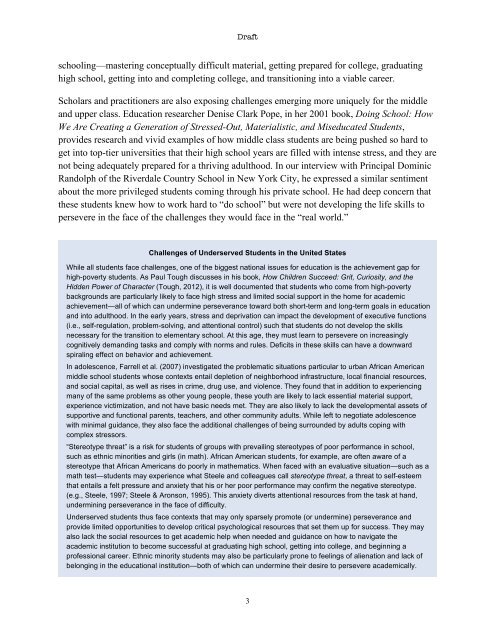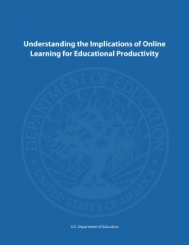Promoting Grit, Tenacity, and Perseverance - U.S. Department of ...
Promoting Grit, Tenacity, and Perseverance - U.S. Department of ...
Promoting Grit, Tenacity, and Perseverance - U.S. Department of ...
You also want an ePaper? Increase the reach of your titles
YUMPU automatically turns print PDFs into web optimized ePapers that Google loves.
Draft<br />
schooling—mastering conceptually difficult material, getting prepared for college, graduating<br />
high school, getting into <strong>and</strong> completing college, <strong>and</strong> transitioning into a viable career.<br />
Scholars <strong>and</strong> practitioners are also exposing challenges emerging more uniquely for the middle<br />
<strong>and</strong> upper class. Education researcher Denise Clark Pope, in her 2001 book, Doing School: How<br />
We Are Creating a Generation <strong>of</strong> Stressed-Out, Materialistic, <strong>and</strong> Miseducated Students,<br />
provides research <strong>and</strong> vivid examples <strong>of</strong> how middle class students are being pushed so hard to<br />
get into top-tier universities that their high school years are filled with intense stress, <strong>and</strong> they are<br />
not being adequately prepared for a thriving adulthood. In our interview with Principal Dominic<br />
R<strong>and</strong>olph <strong>of</strong> the Riverdale Country School in New York City, he expressed a similar sentiment<br />
about the more privileged students coming through his private school. He had deep concern that<br />
these students knew how to work hard to “do school” but were not developing the life skills to<br />
persevere in the face <strong>of</strong> the challenges they would face in the “real world.”<br />
Challenges <strong>of</strong> Underserved Students in the United States<br />
While all students face challenges, one <strong>of</strong> the biggest national issues for education is the achievement gap for<br />
high-poverty students. As Paul Tough discusses in his book, How Children Succeed: <strong>Grit</strong>, Curiosity, <strong>and</strong> the<br />
Hidden Power <strong>of</strong> Character (Tough, 2012), it is well documented that students who come from high-poverty<br />
backgrounds are particularly likely to face high stress <strong>and</strong> limited social support in the home for academic<br />
achievement—all <strong>of</strong> which can undermine perseverance toward both short-term <strong>and</strong> long-term goals in education<br />
<strong>and</strong> into adulthood. In the early years, stress <strong>and</strong> deprivation can impact the development <strong>of</strong> executive functions<br />
(i.e., self-regulation, problem-solving, <strong>and</strong> attentional control) such that students do not develop the skills<br />
necessary for the transition to elementary school. At this age, they must learn to persevere on increasingly<br />
cognitively dem<strong>and</strong>ing tasks <strong>and</strong> comply with norms <strong>and</strong> rules. Deficits in these skills can have a downward<br />
spiraling effect on behavior <strong>and</strong> achievement.<br />
In adolescence, Farrell et al. (2007) investigated the problematic situations particular to urban African American<br />
middle school students whose contexts entail depletion <strong>of</strong> neighborhood infrastructure, local financial resources,<br />
<strong>and</strong> social capital, as well as rises in crime, drug use, <strong>and</strong> violence. They found that in addition to experiencing<br />
many <strong>of</strong> the same problems as other young people, these youth are likely to lack essential material support,<br />
experience victimization, <strong>and</strong> not have basic needs met. They are also likely to lack the developmental assets <strong>of</strong><br />
supportive <strong>and</strong> functional parents, teachers, <strong>and</strong> other community adults. While left to negotiate adolescence<br />
with minimal guidance, they also face the additional challenges <strong>of</strong> being surrounded by adults coping with<br />
complex stressors.<br />
“Stereotype threat” is a risk for students <strong>of</strong> groups with prevailing stereotypes <strong>of</strong> poor performance in school,<br />
such as ethnic minorities <strong>and</strong> girls (in math). African American students, for example, are <strong>of</strong>ten aware <strong>of</strong> a<br />
stereotype that African Americans do poorly in mathematics. When faced with an evaluative situation—such as a<br />
math test—students may experience what Steele <strong>and</strong> colleagues call stereotype threat, a threat to self-esteem<br />
that entails a felt pressure <strong>and</strong> anxiety that his or her poor performance may confirm the negative stereotype.<br />
(e.g., Steele, 1997; Steele & Aronson, 1995). This anxiety diverts attentional resources from the task at h<strong>and</strong>,<br />
undermining perseverance in the face <strong>of</strong> difficulty.<br />
Underserved students thus face contexts that may only sparsely promote (or undermine) perseverance <strong>and</strong><br />
provide limited opportunities to develop critical psychological resources that set them up for success. They may<br />
also lack the social resources to get academic help when needed <strong>and</strong> guidance on how to navigate the<br />
academic institution to become successful at graduating high school, getting into college, <strong>and</strong> beginning a<br />
pr<strong>of</strong>essional career. Ethnic minority students may also be particularly prone to feelings <strong>of</strong> alienation <strong>and</strong> lack <strong>of</strong><br />
belonging in the educational institution—both <strong>of</strong> which can undermine their desire to persevere academically.<br />
3
















